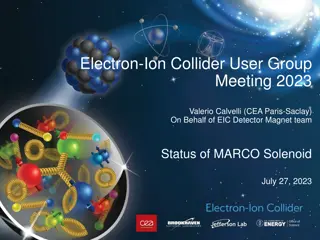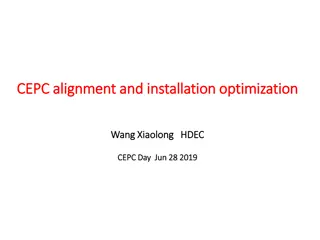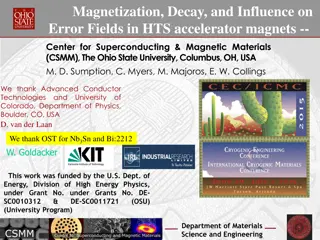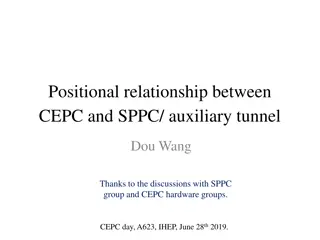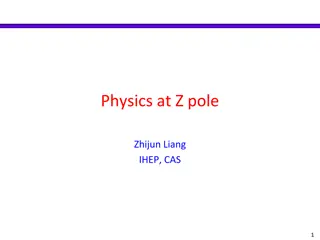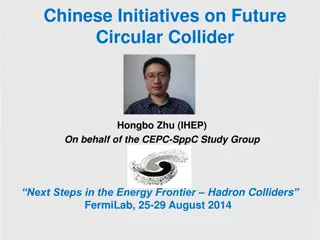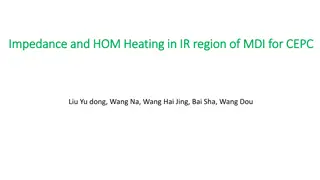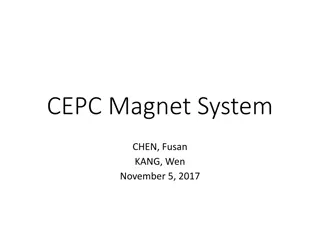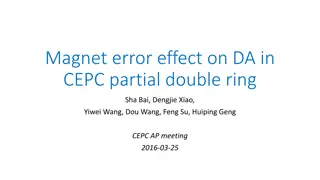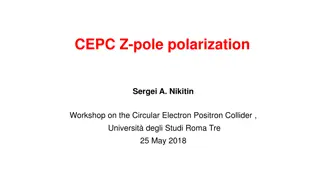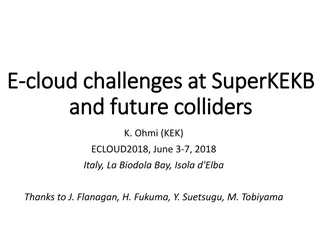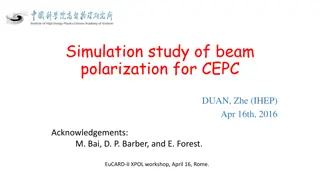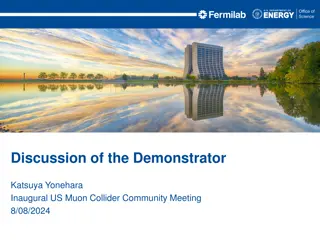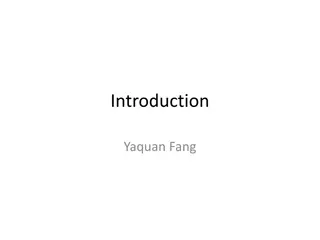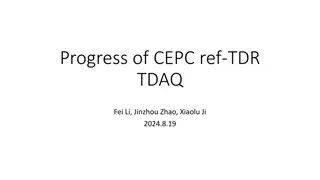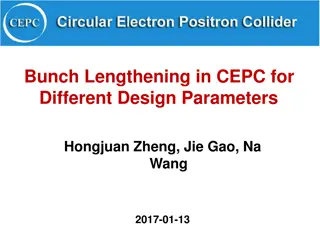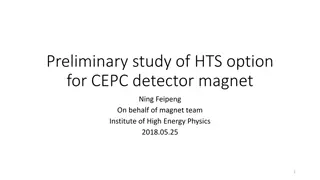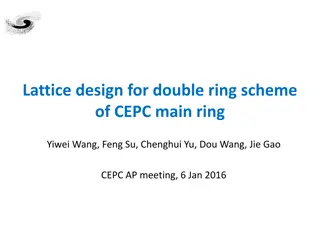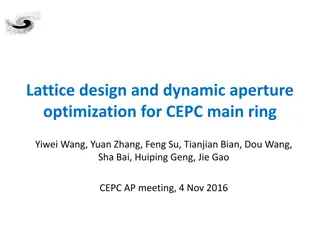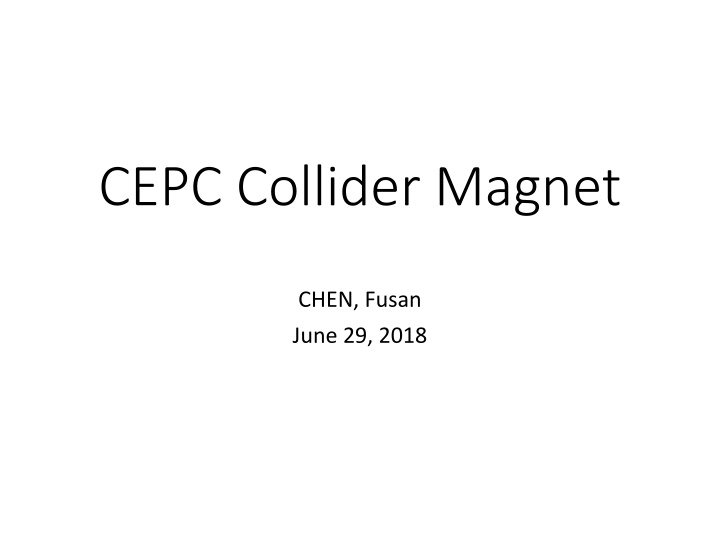
CEPC Collider Magnet Overview
Over 80% of collider ring covered by conventional magnets like Dipole, Quad, Sext, Corrector, Total Dual Aperture. Detailed design considerations for Dual Aperture Dipole and Quadrupole magnets to optimize magnetic field uniformity and reduce power consumption in the CEPC collider project.
Download Presentation

Please find below an Image/Link to download the presentation.
The content on the website is provided AS IS for your information and personal use only. It may not be sold, licensed, or shared on other websites without obtaining consent from the author. If you encounter any issues during the download, it is possible that the publisher has removed the file from their server.
You are allowed to download the files provided on this website for personal or commercial use, subject to the condition that they are used lawfully. All files are the property of their respective owners.
The content on the website is provided AS IS for your information and personal use only. It may not be sold, licensed, or shared on other websites without obtaining consent from the author.
E N D
Presentation Transcript
CEPC Collider Magnet CHEN, Fusan June 29, 2018
Collider Magnet Overview Over 80% of collider ring is covered by conventional magnet. Dipole Quad. Sext. Corrector Total Dual aperture 2384 2392 - - 13742 Single aperture 80*2+2 480*2+172 932*2 2904*2 Total length [km] 71.5 5.9 1.0 2.5 80.8 Power [MW] 7.0 20.2 4.6 2.2 34 The most important issues are Cost & Power Consumption. Make the magnets compact and simple. Use aluminum for the coils. Dual aperture magnets save nearly 50% power. Consider the combined function magnets. Increase the coil cross section and decrease the operating current.
Dual Aperture Dipole Design Length: 28.7m, divided into 5 segments. Combine sextupoles in the first and last segments. Different polarities in different apertures. Reduce the strength of individual sextupoles. SF SD SD SF
Dual Aperture Dipole Design The dual aperture dipole has I shaped cross section. The first and the last segments sextupole combined Dipole combined focus sextupole Dipole combined defocus sextupole The three middle segments dipole only Main coil has two turns instead of one turn to reduce the power loss of cable Trim coils are used for both apertures to adjust the field by 1.5% independently Shielding made of lead protects the coils from SR Core steel Radiation shielding lead Main coil aluminum Trim coil aluminum
Dual Aperture Dipole Design Field optimization Shim the pole to improve the field uniformity. 3 10-4@10mm Tuning the profile to adjust the sextupole component. The cross talk between the two apertures can be ignored. Magnetic strength [T] Aperture[mm] Turns Material Current[A] Currentdensity [A/mm2] Power consumption [kW] Turns Material Current[A] Currentdensity [A/mm2] Power consumption [kW] Velocity [m/s] Flux [l/s] Temperaturerise [ C] 0.037 70 2 Aluminum 1058 0.67 2.73 1 4 Aluminum 16.7 0.093 0.006 1.75 0.138 4.7 9.0E-04 7.0E-04 Main coil DBy/By0-L DBy/By0-R 5.0E-04 DBy/By0 3.0E-04 Trim coil 1.0E-04 -15 -10 -5 0 5 10 15 -1.0E-04 Cooling water x(mm)
Dual Aperture Quadrupole Design Enlarge the main coil cross section to reduce the power loss 50mm gap between yokes to reduce the cross talk of the two sides Shielding made of lead protects the coils from SR The two apertures have different polarities Trim coils are used for both apertures to adjust the field by 1.5% independently Optimize the thickness of the iron plate to compensate the odd order harmonics
Dual Aperture Quadrupole Design 3D simulation The iron plate can not compensate the b1 & b3 at once. Prototype will be developed for further study. Gradient[T/m] Aperture[mm] 8.42 76 64 2 Aluminum 154 1.89 5.3 20 4 copper 7.2 0.9 0.04 1.3 0.201 6.3 Turns Material Current[A] Currentdensity [A/mm2] Power consumption [kW] Turns Material Current[A] Currentdensity [A/mm2] Power consumption [kW] Velocity [m/s] Flux [l/s] Temperaturerise [ C] Main coil Trim coil Cooling water
Sextupole Design Two single aperture sextupoles are installed side by side. Core size is limited by the 350mm beam center separation. Use copper for coils & enlarge the cross section as much as possible. 10mm gap between two magnets but the cross talk can be ignored. Type Magnetic length [m] Gradient[T/m2] Aperture[mm] Turns Material Current[A] Currentdensity [A/mm2] Power consumption [kW] Velocity [m/s] Flux [l/s] Temperaturerise [ C] SF 0.7 SD 1.4 506* 80 26 6 Copper 168.4 4.1 3.3 2.1 0.175 0.269 4.5 Coil 4.7 7.0 1.8 Cooling water Core - steel Coil - copper Radiation shielding - lead 6.2
Cost Estimation Work breakdown structure (WBS) sheet is used to estimate the construction cost. Includes the cost of materials, accessories, toolings, fabrication, test, package & delivery and some commercial costs. Total cost Construction cost + Operation cost Optimize the current density to minimize the total cost. Cost estimation of dual aperture quadrupole for 5 year operation 0.5 1 1.5 2 2.5 3 Current density [A/mm2] Operation cost Construction cost Total cost Optimized density [A/mm2] 5 year operation 1.34 1.95 3.48 Design density [A/mm2] 0.67 1.89 4.1 Magnet type Coil material 10 year operation 0.95 1.38 2.46 Dual aperture Dipole Dual aperture quad. Sextupole Aluminum Aluminum Copper

